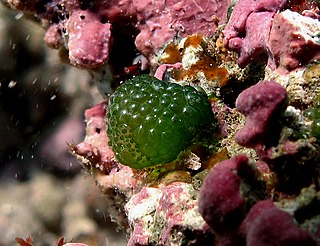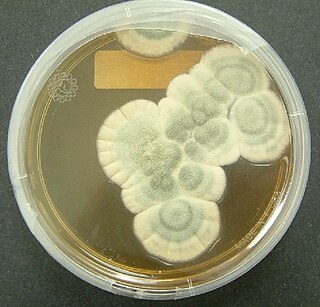
Penicillium roqueforti is a common saprotrophic fungus in the genus Penicillium. Widespread in nature, it can be isolated from soil, decaying organic matter, and plants.

Dictyosphaeria is a genus of green algae in the family Siphonocladaceae.
Penicillium griseofulvum is a species of the genus of Penicillium which produces patulin, penifulvin A, cyclopiazonic acid, roquefortine C, shikimic acid, griseofulvin, and 6-Methylsalicylic acid. Penicillium griseofulvum occurs on cereals and nuts.

Penicillium chrysogenum is a species of fungus in the genus Penicillium. It is common in temperate and subtropical regions and can be found on salted food products, but it is mostly found in indoor environments, especially in damp or water-damaged buildings. It has been recognised as a species complex that includes P. notatum, P. meleagrinum, and P. cyaneofulvum. Molecular phylogeny has established that Alexander Fleming's first discovered penicillin producing strain is of a distinct species, P. rubens, and not of P. notatum. It has rarely been reported as a cause of human disease. It is the source of several β-lactam antibiotics, most significantly penicillin. Other secondary metabolites of P. chrysogenum include roquefortine C, meleagrin, chrysogine, 6-MSA YWA1/melanin, andrastatin A, fungisporin, secalonic acids, sorbicillin, and PR-toxin.

Penicillium rubens is a species of fungus in the genus Penicillium and was the first species known to produce the antibiotic penicillin. It was first described by Philibert Melchior Joseph Ehi Biourge in 1923. For the discovery of penicillin from this species Alexander Fleming shared the Nobel Prize in Physiology or Medicine in 1945. The original penicillin-producing type has been variously identified as Penicillium rubrum, P. notatum, and P. chrysogenum among others, but genomic comparison and phylogenetic analysis in 2011 resolved that it is P. rubens. It is the best source of penicillins and produces benzylpenicillin (G), phenoxymethylpenicillin (V) and octanoylpenicillin (K). It also produces other important bioactive compounds such as andrastin, chrysogine, fungisporin, roquefortine, and sorbicillins.
Penicillium brocae is a fungal species of the genus Penicillium, which was isolated in Chiapas in Mexico. It is a symbiont of the mangrove tree Avicennia marina.
Penicillium citrinum is an anamorph, mesophilic fungus species of the genus of Penicillium which produces tanzawaic acid A-D, ACC, Mevastatin, Quinocitrinine A, Quinocitrinine B, and nephrotoxic citrinin. Penicillium citrinum is often found on moldy citrus fruits and occasionally it occurs in tropical spices and cereals. This Penicillium species also causes mortality for the mosquito Culex quinquefasciatus. Because of its mesophilic character, Penicillium citrinum occurs worldwide. The first statin (Mevastatin) was 1970 isolated from this species.
Penicillium clavigerum is a fungus species of the genus of Penicillium which produces fumigaclavine A and fumigaclavine B
Penicillium coffeae is a fungus species of the genus of Penicillium which was isolated from the plant Coffea arabica L. in Hawaii. Insects play a role in spreading Penicillium coffeae.
Penicillium corylophilum is a species of the genus of Penicillium which occurs in damp buildings in United States, Canada and western Europe but it can also be found in a variety of foods and mosquitoes. Penicillium corylophilum produces the alkaloid epoxyagroclavine and citrinin and is a pathogen to mosquitoes.
Penicillium cyaneum is a species of the genus of Penicillium which was isolated from an oil-field. Penicillium cyaneum produces fatty acid, Brefeldin A and the antibiotic Cyanein
Penicillium decaturense is a species of the genus of Penicillium which was isolated from a fungus in North America. Penicillium decaturense produces citrinin, 15-Deoxyoxalicine B, decaturins A and decaturins A
Penicillium janczewskii is an anamorph and filamentous species of the genus of Penicillium which was isolated from the rhizosphere of Vernonia herbacea. Penicillium janczewskii produces griseofulvin
Penicillium paneum is a species of fungus in the genus Penicillium which can spoil cereal grains. Penicillium paneum produces 1-Octen-3-ol and penipanoid A, penipanoid B, penipanoid C, patulin and roquefortine C
Penicillium rubrum is a species of fungus in the genus Penicillium which produces kojic acid, mitorubrin, mitorubrinol, rubratoxin A, rubratoxin B rubralactone, rubramin and occurs in grain corn and soybeans. Penicillium rubrum is similar to the species Penicillium chrysogenum.
Penicillium simplicissimum is an anamorph species of fungus in the genus Penicillium which can promote plant growth. This species occurs on food and its primary habitat is in decaying vegetations Penicillium simplicissimum produces verruculogene, fumitremorgene B, penicillic acid, viridicatumtoxin, decarestrictine G, decarestrictine L, decarestrictine H, decarestrictine I, decarestrictine K decarestrictine M, dihydrovermistatin, vermistatin and penisimplicissin
Penicillium thiersii is a species of fungus in the genus Penicillium which was isolated from a wood decay fungi (Hypoxylon) in Wisconsin in North America. Penicillium thiersii produces thiersindole A, thiersindole B, thiersindole C, oxalicine A and oxalicine B
Penicillium waksmanii is an anamorph species of the genus of Penicillium which was isolated from the alga Sargassum ringgoldianum. Penicillium waksmanii produces pyrenocine A, pyrenocine C, pyrenocine D and pyrenocine E

Rugulosin is an anthraquinoid mycotoxin with the molecular formula C30H22O10 which is produced by Penicillium species. Rugulosin is hepatotoxic and is cancerogenic.




